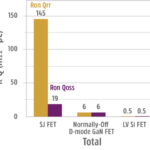(Editor’s note: check out the full article, “The fundamental advantages of D-Mode GaN in cascode configuration,” and get the full technical story behind these “busted” myths.)
Reality: Cascode GaN has a lot of gains. And gain is a wonderful thing, leading to very fast switching. It needs, however, to be harnessed properly to achieve the desired performance while preventing undesired effects, such as oscillations. To prevent oscillations and to get the most out of any fast-switching semiconductor device, circuit engineers should follow standard design principles, such as: minimizing gate and power loop inductances, selecting the correct gate resistor(s) and gate ferrite bead, and/or deploying RC snubbers where needed (mostly at the DC link, as close as possible to the drain terminal of the device). All of these design principles are simple to implement and are summarized in Application Note AN0009.6 If properly implemented, they do not degrade the GaN HEMT’s performance. On the contrary, they enhance it while suppressing oscillations and electromagnetic interferences (EMI). See waveforms in Figure B. Myth Busted!

More myths
Myth #1: Si MOSFETs add-on state resistance reverse recovery charge
Uncover what chip really handles the majority of off-state high voltage — and which one contributes less than 10 percent of the total cascode resistance.
Myth #2: e-mode devices have no Qrr
Yes, GaN HEMTs have no reverse conduction bipolar transport, but completely eliminating Qrr? Think again.







Leave a Reply